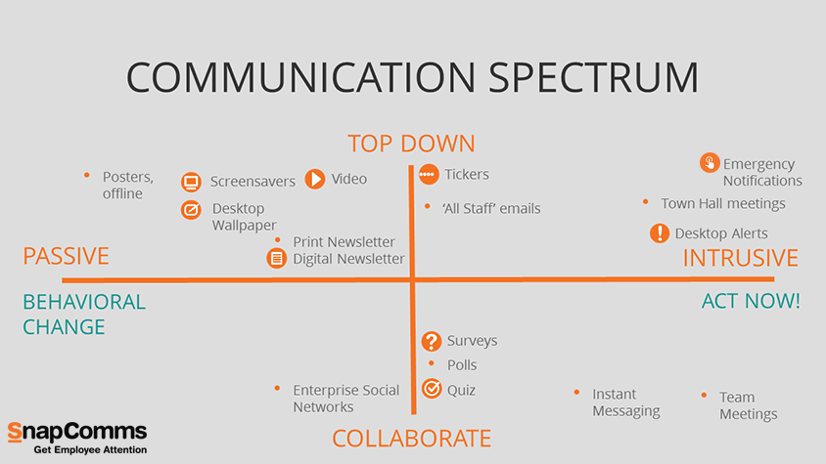
Are you tired of wasting your time writing content that no one reads? Do you feel that no matter how many times you resend an important 'All Staff' email, you’re still not being heard?
Don't take it personally. Employees don’t have the time to open, read and click on everything that lands in their inbox. The roar of information streaming at them is deafening.
Information overload is the biggest challenge facing internal communicators today. And even more so now with increasing pressure to get staff up to speed on important topics such as cyber-security, company culture, and health and safety.
From where I’m sitting I get to see how major organizations are tackling the ubiquitous communication challenge. I’ve noticed a real shift in organizations wanting honest reporting about employee engagement.
The open rate of an email is not a reliable metric for readership. The time spent reading a message, scrolling through, and acting accordingly is. So is it time to face up to the fact that email, an old-fashioned technology, is not up to the task of successful internal communications today?
One large European company we've worked with provides a variety of public services: banking, foreign currency exchange, postal services, and ticket sales to major events. It employs more than 60,000 staff who work across multiple sites, on different shifts.
These staff come face-to-face with literally millions of people each day. They must think fast and act fast – and need accurate information in front of them.
Internal communications at this organization is not for the faint-hearted: no two days are the same. A few recent examples of its ‘standard day’ are:
-
A major bank’s ATM system was disrupted, causing an immediate knock-on-effect for our client, with a flood of inquiries from concerned customers wanting up-to-date information.
-
A national bank unexpectedly announced it would no longer hold the local currency at a fixed exchange rate with the euro, resulting in currency exchange chaos.
-
Concert tickets for an international pop artist went on sale and its in-store traffic went through the roof.
Using email to keep staff up to date during these dynamic, fast-changing situations would have been futile. Instead, this organization uses desktop alerts to publish important content.
This hi-viz channel is perfect for urgent mass notifications to frontline employees. Different groups can be targeted, either by function or location, with relevant messaging. A near 100% readership is guaranteed.
We have many other customers who are undergoing an extreme makeover of their internal communications. They realize they require a variety of tools to achieve their communication goals:
No two channels are created equal
Interestingly, certain tools perform well across the entire spectrum. Tickers for example (also known as desktop newsfeeds) are effective for reinforcing messages (i.e.“Take a screen break every two hours”). But they’re also useful for communicating breaking news or inciting action (“Complete the staff survey now”).
There are times when a collaborative approach is required, where employees’ ideas and opinions must be captured, benchmarked, and actioned.
Other situations require a ‘top-down' approach, where specific instructions or strategies require careful communication, leaving no room for uncertainty. Equally, some messages demand urgent attention with an immediate call to action, while others are a slow burn, building awareness and understanding over time.

Here are some tips for addressing common internal communication themes, along with choosing the most appropriate tools:
1. Internal Communications for Behavioral Change
To inspire and form new employee habits is a long game. The challenge begins with getting staff buy-in. This means explaining the ‘what’ and the ‘why’, before introducing the desired new behavior. To do this effectively requires a campaign approach delivered over a defined period, with messages presented using the full spectrum of tools.
Techniques that prompt behavior change include prominent employees and influencers walking the talk, workshops and training, case studies, consequential scenarios i.e. what happens if you do or don’t adopt this new behavior, expectations, and goal setting.
Nudging people along in the right direction can only be done by the systematic drip-feeding of messages. Research indicates it can take as many as seven exposures before new information sinks in. Reinforce behavior with passive reminders delivered via screensavers, corporate wallpaper (which are viewed when employees switch on their machines each day), scrolling desktop tickers, and internal newsletters.
It’s important to provide genuine examples of positive behavioral change in action. Employee-fronted content, such as short videos and interviews, encourages mimicry. Public recognition, reward, and praise all contribute towards driving the correct behavior.
Remember to measure the impact of your behavioral change campaign. A quiz or survey is an effective method for tracking progress. Verification from the employee to confirm they will adopt the new behavior can be collected via a validation digital response.
2. Building a Corporate Culture
This is another important but long-term communication task. Organizational culture can be described as the portrayal of shared attitudes, values, and standards. But communicating all this in a memorable and engaging way requires creativity, repetition, and different channels to suit different learning styles.
‘Culture campaigns’ comprising multi-media content delivered via video, screensavers, and tickers are great for creating momentum and reinforcing key messages. Encourage attendance at culture-related events, such as Town Hall meetings or roadshows with an RSVP tool. This can be set to re-notify employees about an upcoming event until their response has been received.
Newsletters have come a long way since the single-sided A4 update. These days, their digital format provides a dynamic environment for rich media content such as video, tickers, and interactive polls that lift readership and engagement.
Ensure you provide a mechanism to capture employees’ input. Forums, quizzes, and surveys provide public and private ways to get staff to share their opinions.
3. Emergency Communications
There are times when getting a message out fast is critical. The methods used to warn staff not to open a malicious email, manage an internal crisis, or broadcast emergency instructions in the event of a natural disaster or shooter on-site, can dramatically affect the outcome.
Panic Button-style alerts that flood all available channels such as desktop, digital signage, and employees’ mobile phones are highly effective as they can override screens and deliver an important message, regardless of the employee’s location. Feedback features such as ‘Yes’ I’m safe” help Incident Teams manage an unfolding situation.
In summary, experiment with new internal communication channels. There are many new and exciting ways to interact with employees – many of which bypass email completely.
This article has been published by HR Technologist

